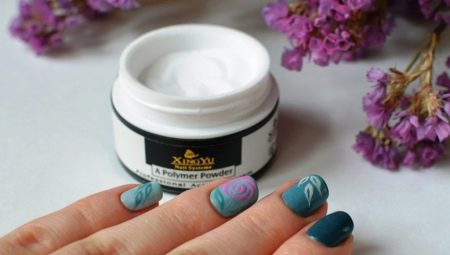Every modern woman wants her nails to be strong, beautiful and healthy. Alas, far from all, nature has endowed such riches, so more and more women began to turn to strengthening nails with acrylic powder. It is worth considering in more detail what it is, to get acquainted with the advantages and disadvantages of this material and the principles of its use.
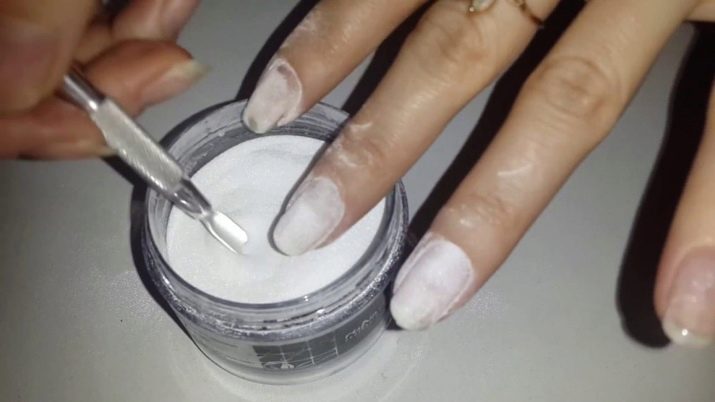
What it is?
Few of us have thought that acrylic powder has a wide range of applications. More recently, it was successfully used in dentistry, leveling the surface of a filling. The substance is a synthetic polymer powder that cures upon contact with a special fluid called a monomer.
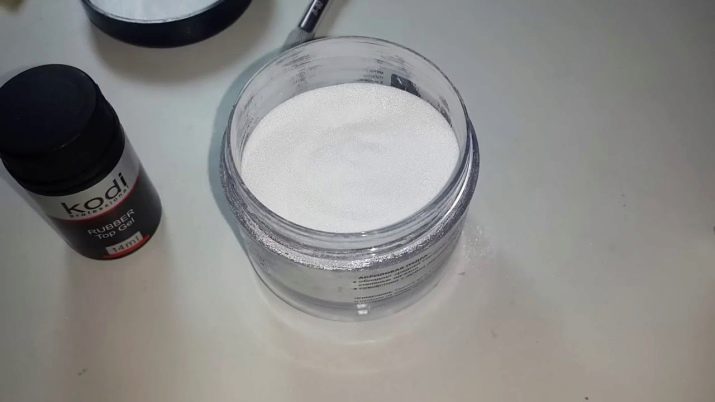
It is this feature that allows the use of powder to strengthen nails. Subject to all the rules of use, it will be at least two weeks to keep the powder on the nails.
Features
When powder interacts with liquid (monomer), quick hardening occurs. This suggests the need for both accurate and quick work. Otherwise, it may be necessary to alter a poor-quality result. A distinctive feature of this substance is its ability to fill even microcracks, due to which it is possible to restore a flat and smooth surface of the nail.
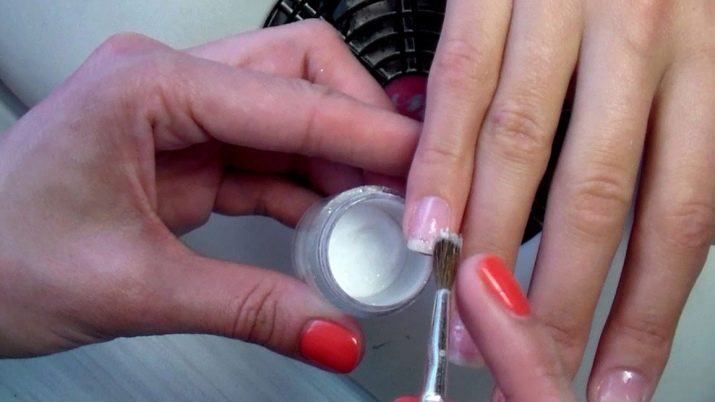
Strengthening is the main task of this powder. At the same time, quality work often may not need a decorative coating, because it looks natural and aesthetically attractive.
However, no matter how you would like to use acrylic powder to restore the nails, it is worth considering limitations, since the material has its contraindications. For example, with nail damage by a fungus, this strengthening is excluded. It is undesirable to perform such a procedure during pregnancy.
There are situations when the use of powder does not give the desired result. For example, it is useless to use acrylic powder to strengthen or build up nails in case of diabetes, intestinal diseases or hormonal system failures. It also matters the type of hygienic manicure for strengthening. For example, with the cutting technique performed with the cuticle removed with cutting tools, you can use acrylic only a day after the cuticle is processed.

Thus, the master reduces the risk of infection and allows the skin to calm down after manipulations to clean out pterygium.
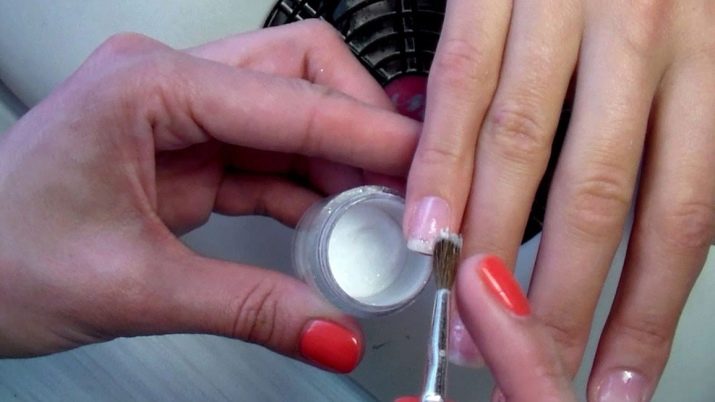
Benefits
Acrylic powder has a lot of advantages. For example, due to the porous structure, it allows the nails to breathe, which is important for their growth and health. In addition, the hardening powder covering the surface of the nails resists their delamination and brittleness. And also it is a protection of the nail plates from environmental factors. The powder protects the nails from exposure to cold and ultraviolet radiation, does not allow them to collapse under the regular influence of household chemicals. A high-quality product during operation forms an even coating without any bubbles and inhomogeneities. Acrylic powder is also good because it does not harm the nails themselves, which cannot be said about helium products. In addition, with regrowth, the natural form of their nails is preserved.
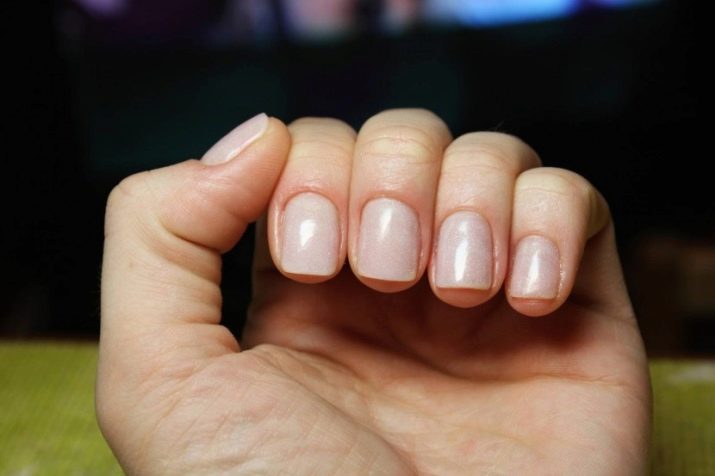
This powder also has such advantages:
- powder is variable in color solutions, due to which it is possible to give them not only a healthy look, but also to decorate with texture;
- with a thin coating layer, the material looks quite natural;
- building is amenable to correction, and both procedures are simple and do not take much time;
- material removal is quick and easy;
- the maximum usability of manicure with acrylic powder can be four weeks.
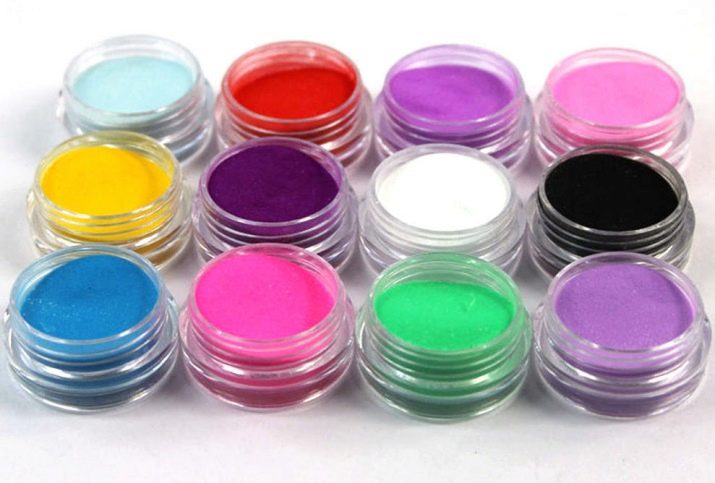
disadvantages
Today, the market for nail products presents a lot of low-quality powder, which is the cause of an allergic reaction. This causes significant damage to the reputation of the powder as a whole, because customers, after hearing negative reviews, may refuse to use acrylic powder. In the work you need to observe not only the utmost accuracy: any deviation from conventional technology can affect the nail and lead to damage or infection. The antiseptic treatment of nails and the skin around them in this case is an integral part of the work process.
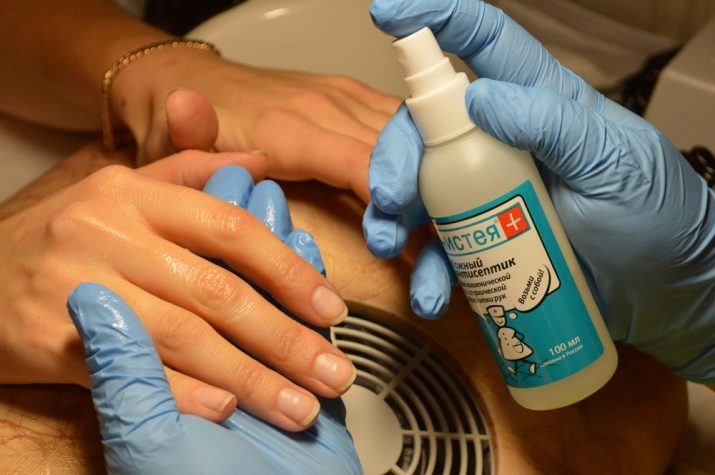
Acrylic powder is a material that is not so easy to choose. Not every powder of this type is capable of tightly gripping the plate itself without spreading it. Often, the powder crystallizes during work and is not amenable to manipulation by the master. Ideally, it should have a porous texture. When working with this material, the natural gloss of nails disappears. It is worth noting the nuance that making the first time perfect coverage at home will not work. It requires at least minimal skills and practice. In the salon, manicure with acrylic powder is expensive.
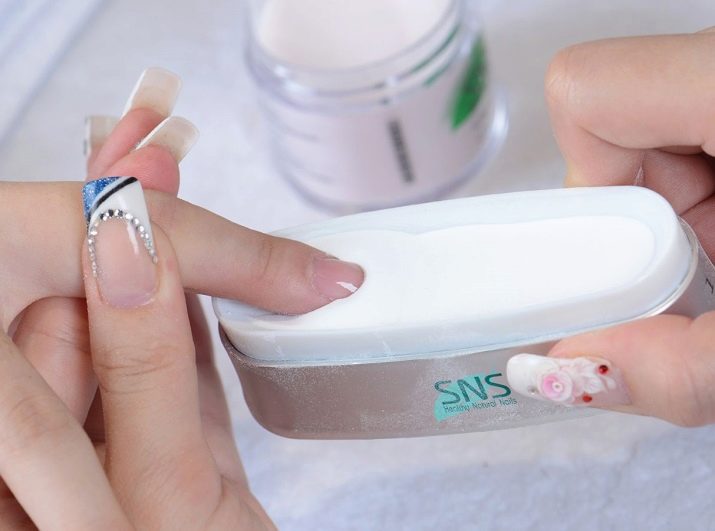
Forming a greenhouse effect when layered on the nail, the powder can aggravate the condition of diseased nail plates. Regardless of the use of an antiseptic in this case, it will become a catalyst for the development of nail fungus. This material is not a cure or mask for problem nails.
In addition, it is characterized by a rather specific smell, which is present in most varieties.Therefore, it is contraindicated for some clients: there are cases of malaise during the manipulation process associated with the use of the drug.
How to apply?
You can use acrylic powder not only in the salon, knowing the basics of manipulation, but you can quickly master the technique at home. It is worth considering the basic nuances of work for beginners, stopping at each stage step by step, which will simplify the acquaintance with acrylic powder. To do this, prepare the following materials:
- manicure wipes;
- dehydrator;
- acetone-containing liquid;
- liquid soap;
- soft grinder;
- antiseptic;
- monomer;
- small capacity;
- acrylic Powder.
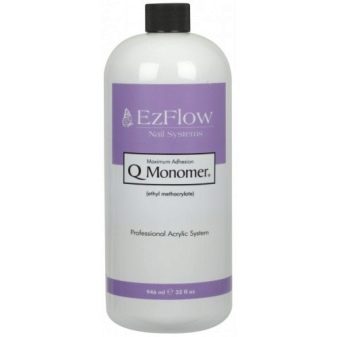
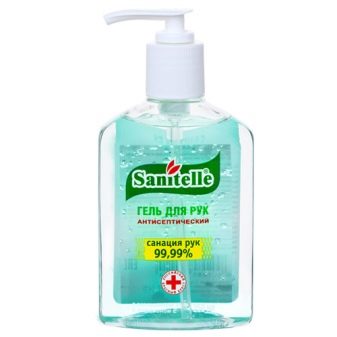
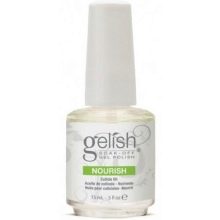
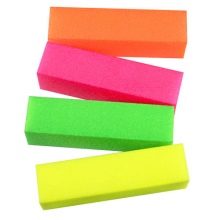
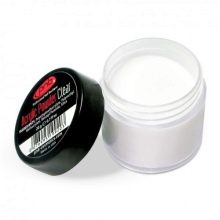
First, disinfect the hands, washing them with liquid soap. Next, they are wiped dry with a towel. With the help of acetone they get rid of the old coating. It is preferable to use a liquid that contains essential oils or nutrients. If there is a hybrid varnish on the nails, it is removed using a special liquid.
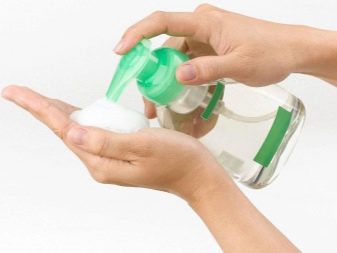
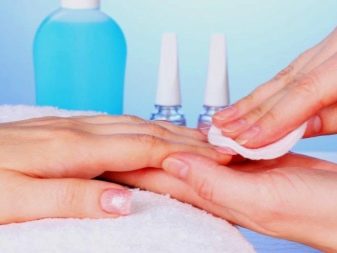
Each nail is treated with an antiseptic. At the same time, it is impossible to fill nails with the product, since any antiseptic contains moisturizing components. The more they will be on the nail, the more difficult it is to remove, and the coating will not be able to stay on such a basis for a long time. After processing, each nail is aligned with a buff (grinder). You can not use a rough file, because of this, furrows and sticking scales will appear on the surface of the nail plate.

After this, the cuticle is usually removed and the pterygium is scrubbed using an orange stick. Excess skin is cut with scissors, residual sawdust is removed first with a special brush, then cleaned with a dehydrator (degreaser). At this stage, preparation for applying acrylic ends. Further work will depend on the type of application of the material itself. Based on this, in addition to the acrylic and monomer itself, you may need: a primer (special helium primer), a nail file, a keratolik, a brush.
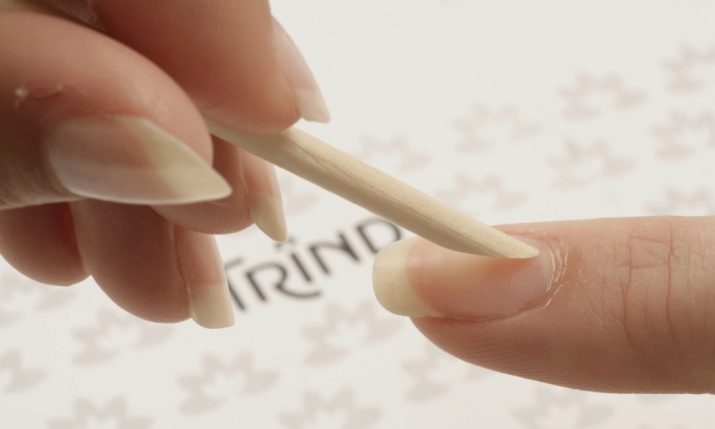
The work scheme consists of the following steps:
- monomer is poured into a separate container using a small amount;
- the brush is dipped in liquid (monomer), the excess liquid is allowed to drain or the brush is slightly squeezed against the edge of the container;
- a little powder is collected on the tip of the brush and wait until it acquires the desired form (it becomes a plastic mass);
- the mass is applied to the nail with a confident movement, retreating from the cuticle no more than 1 mm;
- after drying, correct irregularities of work;
- the base surface is sanded with a buff.
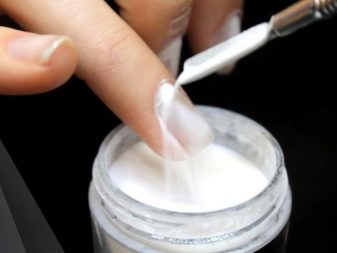

If necessary, you can apply acrylic powder again. In general, the basic technique cannot be called finished, since almost always the female soul requires the maximum aesthetic appeal of nails, which can be achieved by staining them.
Therefore, it is worth considering strengthening only the initial phase of a manicure. The prepared base is often stained with hybrid varnishes, decorated with sparkles, inlaid with rhinestones and Swarovski crystals.

The nuances of work
With any preparation of the nail, it is important to understand that a lot will depend on the tools. For example, you need to use nail files with different abrasives in your work. For the edge, it is more advisable to use the product with large particles, to model - it is easier than the average, to grind - the smallest and soft, not rubbing the nails themselves. It is important to pay attention to the need to use a primer that will bond acrylic to a native nail. The primer in this case acts like a double-sided tape, it can be used even for sensitive nails. A pusher, cuticle softener, plastic tips can be useful to someone.
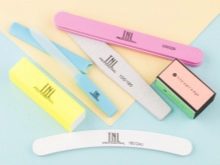

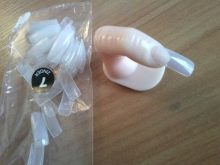
Brushes are also important, since applying a high-quality coating will be possible only with those that have an elastic and dense pile. Simulation itself is easier to perform with a round-shaped product with a sharp end. It is easier to get rid of sawdust with a wide brush.In other words, the tools are not universal, for each stage they use the one that better and better cope with its task.
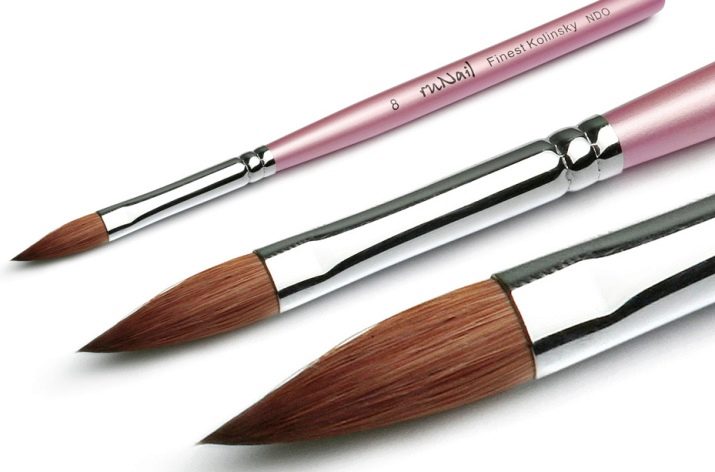
What is it used for?
Initially, the powdery powder had one color and was used mainly during building, which was explained by high ductility and a set of strength during the drying process. Nail service professionals have learned how to use acrylic powder to repair damaged nails and even creative designs. In addition to artistic modeling, using nail powder, they perform nail art in French design. And also this material is used for further gel-varnish coating. At the same time, the powder itself looks natural and aesthetically attractive. However, working with it may seem difficult, because you need to choose the right powder and follow the detailed instructions exactly. It can fill in existing microcracks and bumps in the nails, prepare a good and strong foundation for excellent adhesion to gel polish.
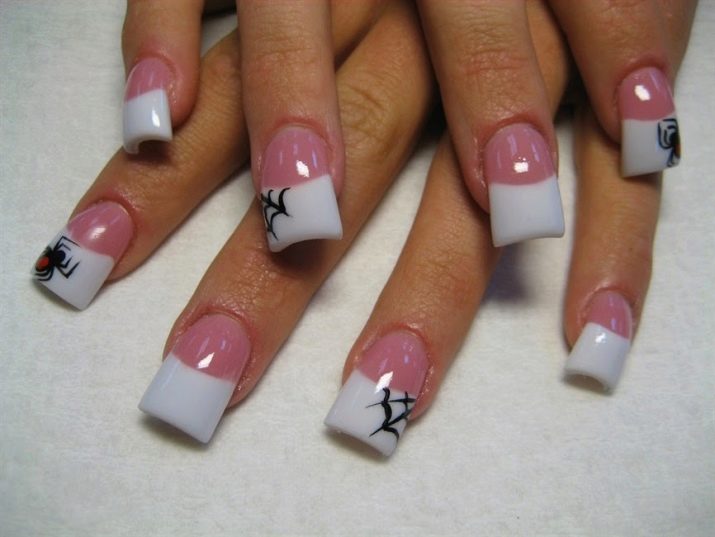
And also the use of the material is relevant when restoring exfoliating nails and leveling the relief, giving the plate a beautiful arch and a natural shade.
Strengthening
The technique of strengthening nails with acrylic powder is needed if they are thin, brittle and do not hold the coating well. The technique significantly increases the resistance of marigolds to mechanical damage. At the same time, nails are not afraid of water, since the material does not soften in it even with prolonged exposure. It is advisable to use a medical mask, open the window.

You can strengthen the nails in another way. To do this, first you need to perform a hygienic manicure, align the length, make the edge on all ten nails identical, clean the cuticle and pterygium. After grinding on the nails, you need to apply a primer and dry it, since the lack of drying will cause a quick detachment of any material. After that, monomer is applied to the nail plate, pick up the pusher in their hands, they collect acrylic powder on it and sprinkle their nail plate.
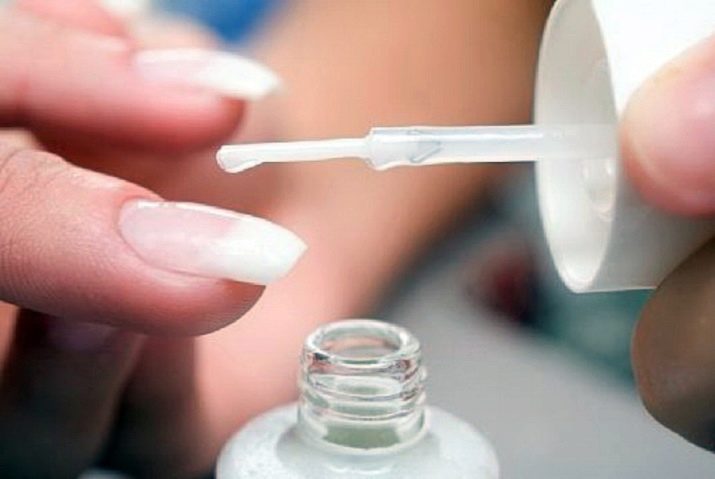
Sprinkle generously without touching or rubbing the powder into the surface of the nail. It is necessary to take a transparent powder for strengthening. In order to save powder, you need to hold the nail over a jar of powder. As soon as the nail is showered with powder, it is immediately dried in a lamp. The polymerization time depends on the type of lamp and can be from 1 to 2 minutes.
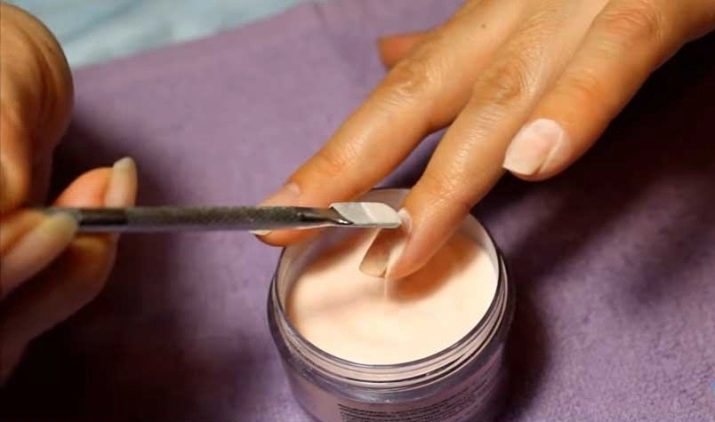
After drying with a brush, the remains of the powder are removed, and the coating is adjusted. If necessary, it is ground and subjected to easy correction. After you can coat the nails with gel polish. If you do not want to carry out the reinforcement in this way, you can act according to the standard scheme. As for strengthening without building, it is advisable to lengthen the existing length by at least 2 mm. Doing this is necessary so that the acrylic does not break off from the end of the nail. In addition, this procedure will be the prevention of chips.
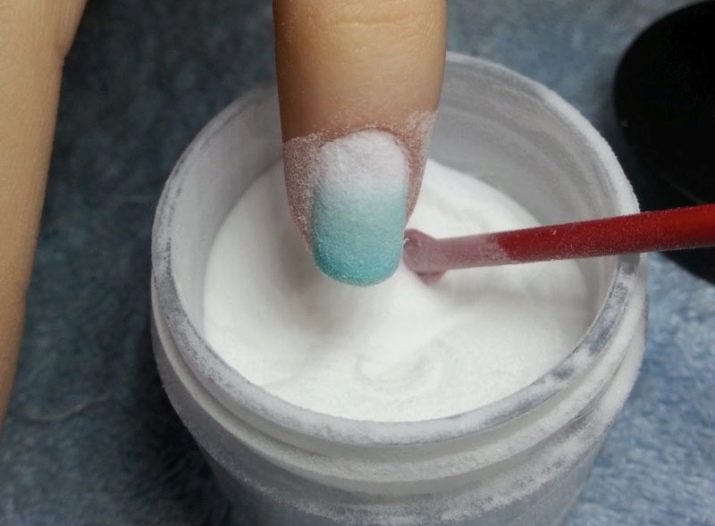
Escalation
The process of nail extension with acrylic differs from the usual strengthening in that you will have to not only distribute the composition on the nail plate, but also form an arch. It is worth considering that the difference may be the layer of applied powder, because it will depend on the individual characteristics of specific nails. To simplify the task, it is easier for novice masters to use special tips or upper forms, because it’s easier to build the desired shape and length. In addition, the use of forms will reduce the duration of building and manicure in general. You should not resort to paper templates for the first time, since working with them is more difficult than with tips. The technique itself will require the preliminary implementation of a hygienic manicure, and it is also worthwhile to pre-select the sizes of the patterns that are more suitable for your nails than others.
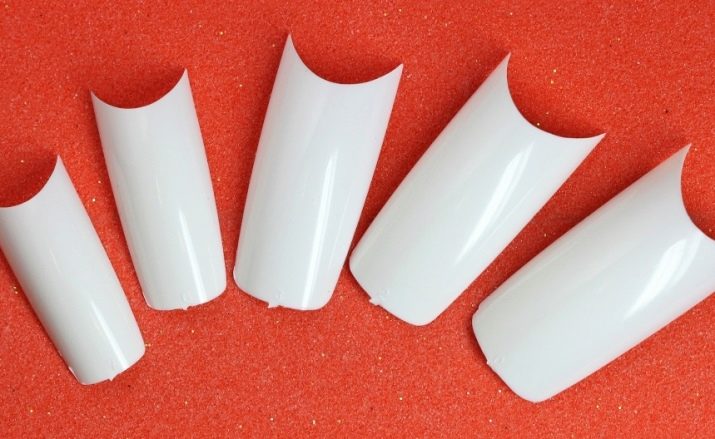
After that, first apply a primer to the nails, dry it, then proceed to create a beautiful shape and desired length by performing the following steps:
- the brush is dipped in monomer, then immediately in a jar of powder;
- as soon as a plastic ball forms on the tip, it is applied to the inner side of the upper form and with thin movements creates a thin coating of the desired length;
- the material is distributed evenly from two sides, while leaving in the central part more means for forming an arch;
- you need to try so that the acrylic composition on the sides comes to naught, because with an excess of substance it can creep out of the mold;
- Immediately after applying the powder, the form is applied to the nail and pressed tightly;
- after this, the form is removed, the nail is filed and polished if necessary;
- Further, you can begin to stain and design on accent nail plates.

If we approach the issue of building correctly, then you can immediately purchase a ready-made kit, which includes all the necessary substances and tools that allow you to perform high-quality and durable nail extensions. At the same time, with the same powder it will be possible not only to strengthen or build up nails, but also to make timely repairs or correction of plates in case of detachment of the material.
The presence of a kit is convenient for a novice master, since with it you can fix your nails immediately, as indicated by the need.

Design
One of the possibilities of acrylic powder is a decorative function. Today, on store shelves, this powder is presented in a wide variety of options and modifications. For example, you can buy shiny glitter or the so-called acrylic sugar. Powdered sugar can have different sizes of microparticles, due to which nail service professionals immediately determine in which design it can be used. For example, options with a small fraction of microparticles allow you to create different contours of the drawings, and quite accurate and clear. Those varieties that are larger are good for completely sprinkling nail plates. Due to this, the masters create the effect of the game of different textures, which today is considered one of the trend trends in nail fashion.
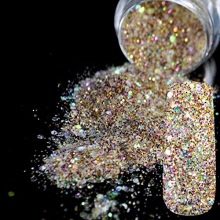
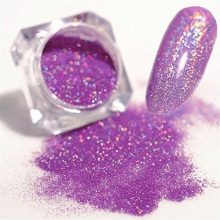

Given that acrylic powder is now available in a wide color palette, then this opens up a lot of opportunities for design and creating volumetric drawings. For example, this material is used when you need to create a knitted texture that is popular today. The whole secret lies in drawing a pattern on the nail, for example, a knitted braid, and sprinkling it with powder, followed by drying in a lamp. By this principle, you can create various color compositions and patterns. For example, a gradient created using colored acrylic powder will look chic.
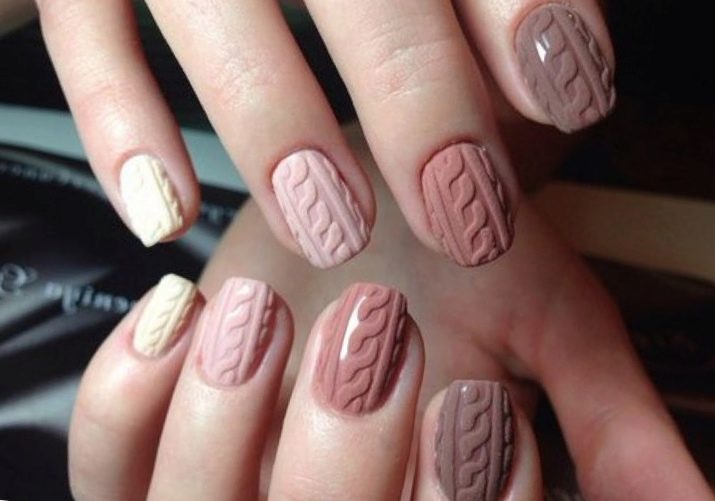
The original type of design is painting on a painted base, complemented by a rub. For example, it can be gold, silver, pearl or even mirror pollen. The technology in this case will be as follows:
- perform hygienic manicure;
- primer is applied to the nails, dried in a special drying device;
- on top of the primer cover the base, which is also dried in a lamp;
- the nail is stained with pigment (gel polish or gel); each applied layer is performed with sealing of the end of the nail and obligatory drying;
- after that, the painted coating is sealed with a top without a sticky layer;
- then the top is dried and the desired pollen is rubbed into it using a finger or an applicator;
- on the rub, they draw patterns or flowers, lines, other motifs, using a transparent modeling tool;
- the nail is sprinkled with the desired acrylic powder and dried in a lamp;
- the remaining powder is removed with a special brush.
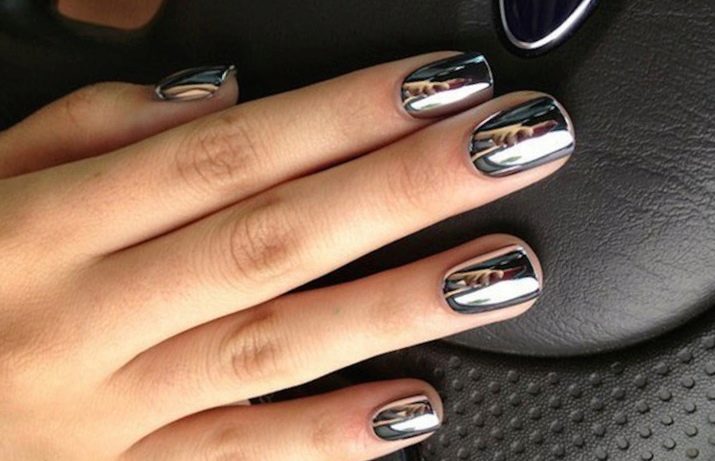
You can draw a substrate for the design with a brush or a regular needle. The main thing is to carry out the lines and contours as evenly as possible so that the powder fills them evenly and densely. It is important to consider that the material does not tolerate correction when performing contours or drawing, so you need to try to do everything beautifully and correctly the first time.
How to take off?
Removing acrylic is easy.No need to tear anything off, as this will harm your nails. To remove the acrylic layer, it is enough to use a special liquid in which the nails are soaked for about 15 minutes. After the required time, the coating is removed with an orange stick. As a rule, the material dissolves acrylic well, so after 15 minutes it is removed without much effort.
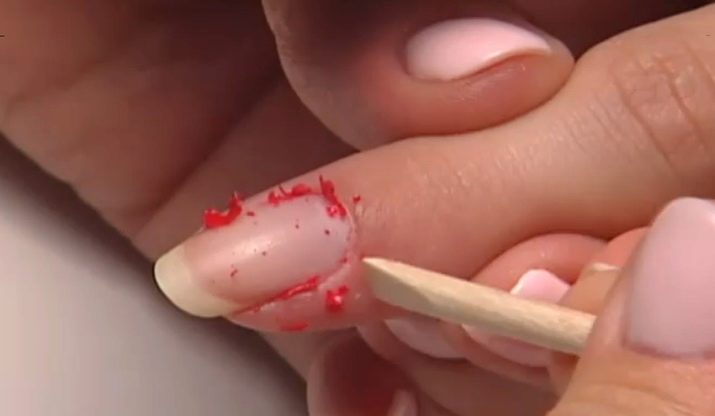
Experts working with acrylic powder, note that in no case should you overexpose the nails in the solution, as this can cause painful irritation of the skin. More often a single nail wrap, reuse of cotton pads or napkins is extremely rare.
Sometimes masters even remove this material with the device. At home, you can use a file for 100-120 grit, delicately removing a layer of acrylic. However, it is better not to resort to nail files, so as not to injure natural nails.
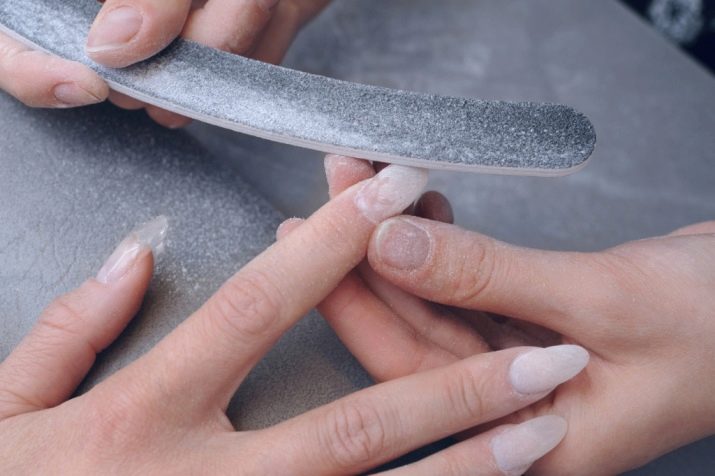
What to consider?
Acrylic powder is not a universal powder that is used for all types of applications. In fact, each function has its own powder. It differs in output, particle size and often quality, which is noted by highly qualified nail service masters. The product that is used for sprinkling and building may not be suitable for decorating nails, and especially if you want to make a small pattern. In addition, the powder may have a different texture. If one variety can be coated on top with a sealing agent, then the other does not need it. The same can be said about polishing: this phase is not needed if a relief pattern is created with acrylic powder.
As for the file material, it is impossible to use a metal product in work. When buying the right product, you need to carefully study its characteristics on the labeling. Upon contact of the monomer and the powder, the acrylic material is densified and dries quickly. You will have to work quickly and with minimal rubbing of the layer in the same place. It is worth noting the price issue, as often among cheap materials come across products that harm the skin and the nails themselves. And it is also important not to forget about the rest of the nail plates, because from constant building and strengthening they can weaken.
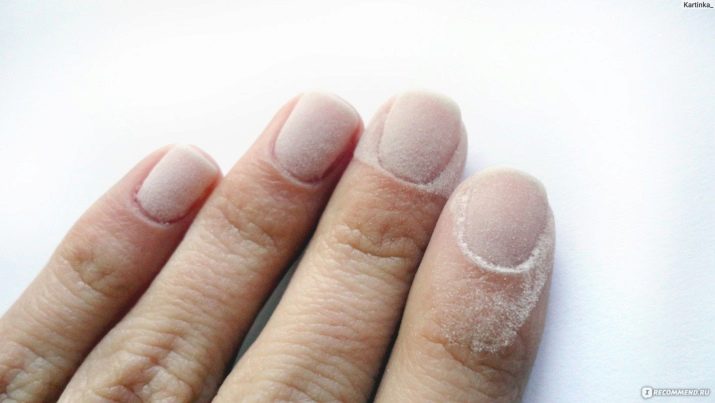
Reviews
Being one of the most discussed topics in the field of nail art, acrylic powder for nails receives a lot of conflicting reviews. Fans of this powder note the flexibility of extended nails while increasing their strength. In addition, they highlight the convenience of a translucent texture that allows you to adjust the shade of the powder. Women also like the possibility of partial correction of nails, because for it you do not need to remove previously applied material.
Other reviews highlight the negative aspects of the material. For example, those who got acquainted with this powder write that this procedure is not so harmless, since during it there is a high probability of infection with nail fungus. It is important to prevent air from entering between the nail and acrylic.
Women note that after some time after building or strengthening the nails require rest and recovery.
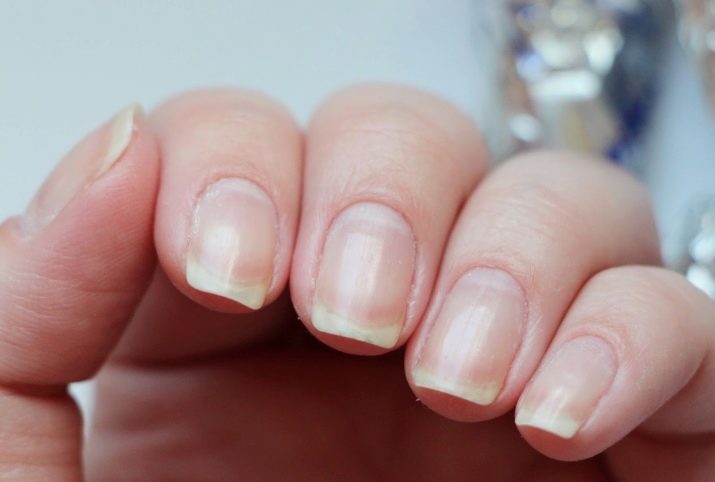
How to strengthen nails with acrylic powder, see the video below.
